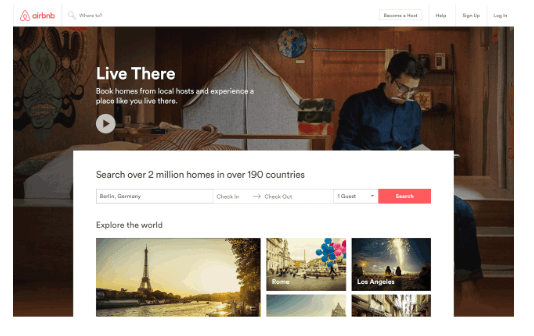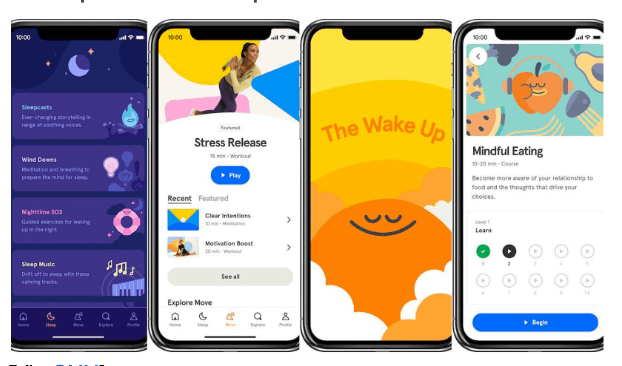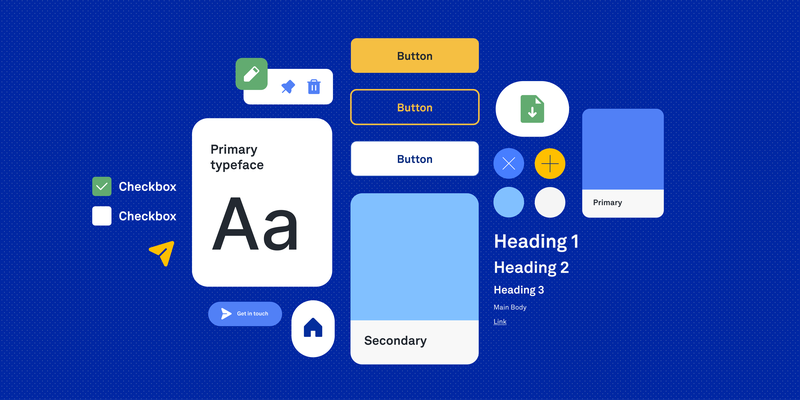Have you ever seen a colour, font, or image and instantly recognised the brand it’s associated with? That’s the power of brand consistency.
In today’s digital era, brand consistency is essential—and for content designers, it pays to get it right. With clear and concise content throughout your digital presence, you can cultivate an atmosphere that truly resonates with your audience and sets you apart from competitors.
On the other hand, a lack of consistent branding could undermine your brand’s authority and detract from your messaging.
In this blog post, we’ll explore how companies have successfully achieved consistent branding in content design, and offer practical tips on how you can do the same.
- What is content design?
- What is brand consistency in content design?
- Why is consistent branding important in content design?
- 3 great examples of clear and consistent branding in content design
- 5 things content designers can do to ensure brand consistency
- The takeaway
What is content design?
Content design is the multidisciplinary art of designing user-focused, engaging, and effective content for websites, apps, and other digital platforms. It involves a strategic approach to crafting content (including text, images, videos, and audio files) that meets user needs while achieving business objectives.
In the digital age, content design is fast becoming a crucial pillar of UX. Users expect high-quality, well-designed content tailored to their specific needs. Effective content design can help businesses to attract and retain users, improve accessibility, and ultimately drive conversions.
To achieve this, content designers work closely with UX/UI designers, researchers, and developers to devise content strategies that help guide users through the digital product. You can learn more about content design in our informative guide.
What is brand consistency in content design?
Brand consistency is all about creating a cohesive and engaging brand experience for your audience. When your company’s brand identity is communicated in a consistent and cohesive manner across all channels and touchpoints, you can build brand recognition and trust with your user base.
For content designers, this means establishing and adhering to a set of brand guidelines for all content, including language, image style, typography, messaging, grammar and mechanics, and tone of voice. These guidelines help ensure that all content is consistent and aligned with the brand’s overall identity.
But brand consistency isn’t just about keeping things looking and sounding the same—it’s about storytelling and communicating your brand’s values to your audience in a way that resonates with them. By creating a compelling narrative that ties the entire product together, you can create a more engaging and memorable brand experience overall.
It’s also important to note that establishing brand consistency isn’t a one-time thing. It’s an ongoing process that requires constant attention, maintenance, and iteration. As your brand identity evolves in line with your user’s needs, keeping your content updated will help you stay ahead of the curve.
Why is consistent branding important in content design?
Consistent branding in content design is key for ensuring your content is as effective and impactful as possible. Let’s take a closer look.
Firstly, consistent branding helps build brand recognition and trust with your audience. When your brand identity is consistent across all channels and touchpoints, your customers know exactly what to expect—and that familiarity can lead to increased engagement with the content.
Consistent branding is also key for cultivating a cohesive, seamless user experience. Strong, consistent content helps users anticipate what comes next; giving them more control over their navigation of the digital product and helping them feel more confident overall.
Consistent branding helps reinforce your brand’s messaging and personality, creating a strong and recognizable brand identity that resonates with your audience and sets you apart from competitors. This also means users are much more likely to remember your content, which—in a world where users are bombarded with content every day—isn’t an easy feat.
So, what about the risks of inconsistent branding in content design?
Inconsistent branding can actively work against your overall UX, leading to negative consequences such as:
- Confusion: Inconsistent branding can create conflicting messages about a brand’s identity. This lack of clarity can confuse and disorient the audience, making the content inaccessible and difficult to understand.
- Diluted brand identity: Inconsistent branding can dilute the brand identity and erode its recognition, leading to a lack of brand loyalty and reduced customer retention.
- Weakened credibility: Inconsistent branding can undermine brand authority, making the content appear unprofessional and disjointed.
It’s safe to say, brand consistency is pretty important!
3 great examples of clear and consistent branding in content design
Example #1: Airbnb
[Via About Airbnb]
Airbnb has managed to create a unique brand identity that truly resonates with their audience. The company’s content designers have made sure the brand’s identity is reflected in everything from their landing pages to email marketing campaigns, and this consistency has been key in building global brand recognition.
Airbnb’s content strategy focuses heavily on storytelling. They use user-generated content to showcase hosts and properties, which helps to ‘humanise’ the experience and create a sense of community and authenticity. The content design is also highly personalised; using user behaviour to tailor the content to individual users’ preferences—which, in turn, boosts the chances of users booking a property.
Example #2: Headspace
[Via CNN]
Popular mindfulness app Headspace has gained widespread recognition for its stellar content design. Headspace’s branding is instantly recognisable for its simple, minimalist aesthetic which evokes a sense of calm and focus—falling in line with the company’s mission to help people improve their well-being.
Headspace’s content strategy and content design are heavily focused on emotional appeal. As well as structuring and signposting each page in anticipation of the emotional states their users might be in when they open the app, they also use encouraging language, playful graphics, and engaging animations to make meditation and mindfulness more accessible and engaging.
Read next: What is information architecture?
Example #3: Ikea
[Via Ikea]
Ikea is a name we all recognise, largely due to their consistent branding. They‘re known for simple, functional, and playful furniture—three characteristics that are reflected across their content. They maintain a distinct and consistent tone of voice across all of their content, whether it’s on their website, social media platforms, or in their offline marketing materials.
Ikea’s branding isn’t limited to digital content, either; they focus on creating a consistent customer experience across all touchpoints—including in-store.
5 things content designers can do to ensure brand consistency
Let’s look at five practical ways content designers can establish brand consistency across their content.
1. Understand the company’s brand identity
Naturally, the first step towards consistent branding in content design is figuring out what the brand identity is. This might seem like an obvious starting point, but if there are already inconsistencies across the branding, it’s likely everyone across the business has a slightly different interpretation of the brand’s DNA. And if it’s not clear what the brand identity is inside the business, how are your users supposed to interpret it?
Establishing the brand identity can include everything from reviewing existing brand guidelines to conducting internal interviews with stakeholders across the business. You’ll also need to conduct in-depth research around the brand’s values, mission, and unique selling proposition—diving deep into the archives to get a clear sense of where the brand’s been and where it’s going. This can be a complex and time-consuming process, but you’ll end up with a clear brand identity everyone in the company can get behind.
2. Conduct in-depth user research
Having a strong brand identity is important. But unless that brand identity actually resonates with users, you’re unlikely to reap any benefits of consistent branding.
Conducting in-depth user research is critical for understanding your audience’s needs and preferences. This research will help you identify which narratives resonate best with your audience, allowing you to tailor your content for maximum impact. Understanding your audience’s motivations and pain points will also help you develop content that speaks to them on a personal level.
When conducting user research, it’s important to remember that each individual will interpret your brand identity very differently. Because of this, make sure you’re researching a diverse group of users; from different demographics, locations, and ability levels. Allow your findings to heavily influence your content strategy—even if it means tweaking the brand identity overall.
3. Develop a style guide
A style guide is a critical tool for establishing brand consistency in your content. A well-designed style guide ensures all cross-channel content aligns with the brand’s identity—from social media posts to product descriptions.
The style guide should lay out comprehensive guidelines for voice and tone, grammar and mechanics, language and messaging, structure and hierarchy, accessibility and inclusion, and even editing and proofreading content.
You can also create content templates that adhere to the brand’s visual identity, including fonts, sizes, and imagery. Defining guidelines for different types of content, like blog articles, downloadable resources, and email newsletters will also help you establish conventions around length and structure.
Developing your style guide should be a group effort. To ensure everyone’s on the same page, it’s important to involve stakeholders across the business—especially senior leaders, and even the CEO. Everyone has a hand in producing and distributing content, so involving every team in the process will only help your efforts to uphold consistent branding.
4. Work closely with product designers
Content and design go hand-in-hand. A close working relationship between content designers and product designers can help to ensure the branding is consistent. This includes ensuring that the visual design elements, such as colour schemes and typography, align with the brand’s identity and messaging.
Content designers should learn about the product design process, and understand how product designers distil the brand’s values through the design. This can help you better understand how content fits into the overall product design, and how you can align your content strategy to the product.
Collaborating with product designers early in the process and throughout the development cycle, as well as asking for regular feedback on the content, will also lead to consistency across the digital product.
5. Regularly audit your existing content
Brand identities and values are always evolving—as are user needs and preferences. To avoid your content quickly becoming outdated, make sure you’re regularly conducting content audits.
Content audits are a powerful tool for maintaining brand consistency. Every content audit is different, but overall, they involve a review and analysis of all existing content—with the goal of identifying what’s working well, what’s not working, and what content is missing. This information can then be used to update the brand’s messaging and content strategy.
With your style guide in-hand, you can evaluate each piece of content against the brand’s messaging and content strategy. This includes checking for consistency in language, tone, messaging, and visual design. Through the evaluation, you’ll identify any inconsistencies or gaps in the content—like outdated language, or references to product features that no longer exist. Then, you can develop a plan for updating the content to align with the current branding.
The takeaway
Consistent branding is a crucial pillar of good content design—and, therefore, good UX. By maintaining a consistent brand identity, you can establish a strong and recognisable brand that resonates with your audience and sets you apart from your competitors.
When establishing brand consistency in your content, it’s important that you reflect user needs (especially when it comes to developing accessible content) but don’t stray too far from brand goals and values. Consistency without being on-brand won’t strengthen your brand’s identity—and it may even lead to confusion down the line.
The key is to regularly review and update your content style guide, communicate those updates to the wider team, and audit your content in line with updated guidelines. In doing so, you’ll ensure you’re remaining in tune with users’ needs and reflecting your evolving branding throughout the content.
To learn more, check out these related blog posts:
- The future of UX writing and content design: 5 major trends
- What is UX writing and how do you do it? Tips for beginners
- What’s the difference between UX writing and copywriting?







